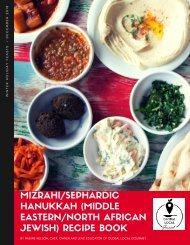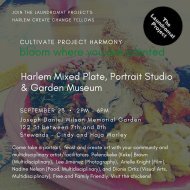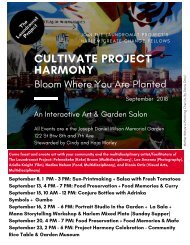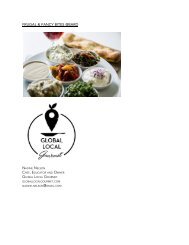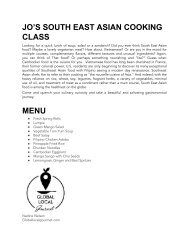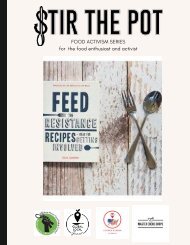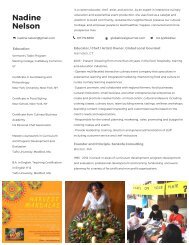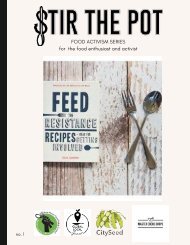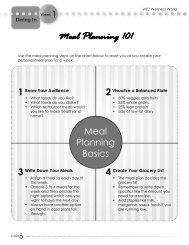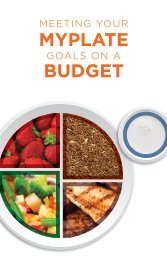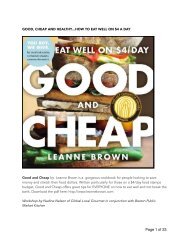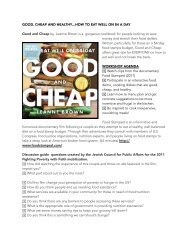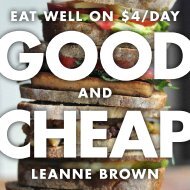Cooking as Revolutionary Act Hand Out - PDF
You also want an ePaper? Increase the reach of your titles
YUMPU automatically turns print PDFs into web optimized ePapers that Google loves.
1 of 9<br />
COOKING IS A REVOLUTIONARY ACT<br />
<strong>Cooking</strong> real food is a revolutionary act. Food is about nourishment and is fundamental to our<br />
existence. As more people do not know how to cook, we have lost the means to care for<br />
ourselves. The kitchen is a revolutionary place for people to feel empowered, learn, connect to<br />
the environment, share their culture, provide fellowship, build community, and cook up<br />
solutions to brainw<strong>as</strong>hed thinking that food costs too much, it is too hard to grow, takes too<br />
long to cook, cuisines of people are color are bad for you (the Med diet is only great diet in<br />
town), people of color can’t liberate themselves and their health because they lack the<br />
knowledge, and the best one for l<strong>as</strong>t, what about food deserts? I will share concrete examples<br />
and methodologies that show how cooking and culinary education can emancipate the food<br />
movement and make it even more delicious, inclusive and equitable.<br />
One of the greatest ple<strong>as</strong>ures of my life h<strong>as</strong> been that I have never<br />
stopped learning about Good <strong>Cooking</strong> and Good Food. - Edna Lewis<br />
Nadine Nelson nadine.nelson@gmail.com<br />
globallocalgourmet.com<br />
917-719-6859
2 of 9<br />
ANATOMY OF A GOOD CULINARY TEACHER<br />
- Exploring & developing your teaching philosophy<br />
- What unique things do you have to offer?<br />
- Skill mining - your culinary strength<br />
(adapted from Apps, J. (1991).M<strong>as</strong>tering the Teaching of Adults. Malabar, FL: Krieger<br />
Publishing Co., pp. 27-35)<br />
Respond to the following prompts in developing a comprehensive record of your beliefs about<br />
the various <strong>as</strong>pects of teaching and learning cooking.:<br />
INTRODUCE YOURSELF THROUGH THIS QUESTION:<br />
How does your personal food story influence your teaching and/or relationship to food and<br />
cooking? How you perceive how people learn about food and cooking?<br />
In Pairs:<br />
1. What are your aims for teaching cooking? What do you hope to accomplish when you<br />
teach cooking? What do your aims say about you <strong>as</strong> a cooking teacher?<br />
2. Create a list in response to the following prompt: “When I teach/ cooking I:” Once<br />
you’ve created the list, reflect on why you do what you do.<br />
3. Why do you believe your students want to learn about cooking? What are some of<br />
their objectives for culinary education? Describe them <strong>as</strong> learners in any way you can.<br />
4. What do you believe about learning how to cook? How would you describe this<br />
philosophy? What are your sources for your beliefs about cooking and one’s ability to<br />
learn how to cook?<br />
From the information you record, you should gain a better understanding of yourself <strong>as</strong> a<br />
cooking teacher. Key themes should emerge to help you create your teaching cooking<br />
philosophy.<br />
TWO INTERACTIVE WAYS TO EXPLORE NEW INGREDIENTS AND RECIPES adapted<br />
from FEEST (Food Empowerment Education and Sustainability Team)<br />
I. “WHAT CAN WE MAKE WITH THIS?”<br />
- write the name of a few dishes on the board<br />
- Assign one or two leads for each dish<br />
- Create a b<strong>as</strong>ic ingredient list and b<strong>as</strong>ic amount<br />
Facilitation Questions:<br />
- Have you ever t<strong>as</strong>ted this before?
3 of 9<br />
- Does your family have a recipe for this kind of food?<br />
- Have you ever cooked this before?<br />
- Have you seen this cooked before?<br />
- H<strong>as</strong> anyone ever eaten this in a restaurant?<br />
- Have you ever t<strong>as</strong>ted anything like this before?<br />
Challenges for students:<br />
- Which of these flavors would go together?<br />
- What is the craziest thing you can make with this?<br />
- What can you not make with this? followed by “wanna bet”<br />
- Can you create a dish for a certain region of the world?<br />
- Propose a challenge to use a particular food item or product.<br />
- Use a certain spice or create a certain flavor.<br />
Reflections:<br />
This activity is an introduction to food itself. It especially works well in talking about ingredients<br />
people do not know. P<strong>as</strong>s the knowledge/ Share the knowledge, prepares the group for the act<br />
of cooking. A great part of the activity is t<strong>as</strong>ting things. It reduces the fear factor or lack of<br />
knowledge for certain ingredients and is a refreshing way to explore the ingredients you will be<br />
using in a recipe. By p<strong>as</strong>sing information between each other, we actively share power. This a<br />
great time to talk about se<strong>as</strong>onal ingredients, sustainability, and nutrition. This exercise also<br />
allows you to <strong>as</strong>ses what the knowledge and skill level of the group is and plan to adapt your<br />
teaching accordingly.<br />
II. YES AND….. BUILDING A RECIPE<br />
Who says too many cooks spoil the kitchen?<br />
The Yes/And Menu is a game an entire room full of people can play in order to create a dish or<br />
even a whole meal. It is a game of communication that teaches students how to work together<br />
in harmony while cooking. One person starts the dish, one by one, everyone in the room adds<br />
on little by little by saying “Yes, and “You can modify slightly or greatly, but you can’t contradict<br />
what came before. We are creating a culture of yes.<br />
Consistently saying “Yes/And” to the people around you expands the sense of what is possible<br />
and pushes and individual’s capacity for innovation and creativity. It gives people the power to<br />
enhance or modify what came before them and creates a powerful sense of possibility and<br />
positivity. It teaches people to simultaneously accept a given situation (Yes!) while improving<br />
upon the situation (And!).<br />
The <strong>Act</strong>ivity<br />
1. Get in a circle.<br />
2. One person volunteers to start a recipe.<br />
3. They say one line of the recipe and then the recipe moves on to the next person.
4 of 9<br />
4. The next person says “Yes, and” and must continue on the idea. The “Yes, and” person<br />
cannot contradict the statement that came before. They can build on it morph it, but not<br />
negate it.<br />
Example:<br />
We are going to make a Kale and Swiss Chard Salad<br />
Yes, and and the greens will be local yes, and they lettuce will include Kale, yes, and the herbs<br />
will be b<strong>as</strong>il ….. .<br />
5. For larger groups, the menu ends when you get back to the first person. Smaller groups may<br />
go around two to three times, building on the same story.<br />
6. Make sure people talk relatively quickly and keep it moving.<br />
7. When finished, <strong>as</strong>k the group how they felt about the game.<br />
- W<strong>as</strong> it e<strong>as</strong>y or difficult to play?<br />
- What made it difficult?<br />
- What made it e<strong>as</strong>y?<br />
- Do you think you can actually make it?<br />
- How e<strong>as</strong>y or how e<strong>as</strong>y or hard w<strong>as</strong> it to say yes to another person’s ide<strong>as</strong> when you<br />
had a different thought? What did it require of you?<br />
- What do you think is the benefit of saying yes to someone’s ide<strong>as</strong>?<br />
- How does it feel when people respond positively to your ide<strong>as</strong>? Which one do you prefer?<br />
Reflections<br />
Depending on what is your intent about what type of cooking cl<strong>as</strong>s or cooking experience you<br />
are trying to create, this activity is great for building a sense of community and will create an<br />
awesome menu that can be fine tuned to work well depending on the group.
5 of 9
6 of 9<br />
CREATE AN ART INTERVENTION<br />
An art intervention is a way of interacting with people, a work of art or specific area. It is<br />
conceptual art that, depending on the ide<strong>as</strong> behind the work, also may be performance art.<br />
The idea is that, using artistic expression, those involved "intervene" in normal activities or<br />
beliefs to initiate some form of change.<br />
An art intervention usually begins when an interventionist identifies a problem in some area.<br />
The interventionist then brainstorms to establish possible ways of making a specific statement<br />
through artistic means.Thus, the scope of the intervention primarily depends on the<br />
imagination and artistic vision the interventionist h<strong>as</strong>, although resources and permission<br />
access can limit the interventionist's choices somewhat. The goal of an art intervention is<br />
always to stimulate modifications to existing systems. The fact art interventions promote<br />
leaving current systems behind means that people sometimes consider art interventions to be<br />
a way of symbolically protesting something and challenging present authority. Depending on<br />
exactly what the interventionists want to do, these challenges sometimes require extensive<br />
work to obtain permissions and licenses. Even when proper authority is granted,<br />
interventionists may face resistance from the public, simply because their views go against the<br />
norm. As a result, interventionists often have to <strong>as</strong>sert their rights to freedom of expression and<br />
speech.<br />
WHAT IS THE PROBLEM YOU WANT TO EXPLORE?<br />
WHAT ARE YOUR RESOURCES AND POSSIBLE COLLABORATORS?<br />
WHAT ARE WAYS OF MAKING A SPECIFIC STATEMENT ARTISTICALLY WITH YOUR<br />
RESOURCES AND PERMISSIONS IN MIND?<br />
WHAT WILL BE THE METHOD(S) TO EXERCISE YOUR INTERVENTION?
7 of 9<br />
RESOURCES TO TEACH COOKING<br />
<strong>Cooking</strong> Matters is key to Share Our Strength’s No Kid Hungry campaign, which connects kids<br />
in need with nutritious food and teaches their families how to cook healthy, affordable meals.<br />
https://cookingmatters.org/ https://www.nokidhungry.org/images/september2013/<br />
Moroccan%20Carrot%20Salad.pdf (My recipe for Moroccan Carrot Salad)<br />
Create Your Plate<br />
You can practice The healthy meal combinations with this interactive tool.<br />
http://www.diabetes.org/food-and-fitness/food/planning-meals/create-your-plate/<br />
The Edible Schoolyard Network connects educators around the world to build and share a<br />
K-12 edible education curriculum<br />
http://edibleschoolyard.org/resources-tools<br />
Food Demonstration Tips & Resources on How to Teach <strong>Cooking</strong><br />
https://snaped.fns.usda.gov/resource-library/cooking/teaching-cooking-skills<br />
Good and Cheap is a cookbook for people with very tight budgets, particularly those on<br />
SNAP/Food Stamp benefits. The <strong>PDF</strong> is free and h<strong>as</strong> been downloaded more than 1,000,000<br />
times.<br />
https://cookbooks.leannebrown.com/good-and-cheap.pdf<br />
Growing Power h<strong>as</strong> served <strong>as</strong> a ”living museum” or “idea factory” for the young, the elderly,<br />
farmers, producers, and other professionals ranging from USDA personnel to urban planners.<br />
http://www.growingpower.org/<br />
Healthy and Homemade, Eating Well on Budget by Juju Harris (Black author and educator)<br />
http://www.npr.org/sections/thesalt/2014/03/13/289594815/former-wic-mom-brings-produceand-cooking-skills-to-dc-s-food-deserts<br />
Contact Juju directly, book is currently being<br />
republished with more content. http://www.nanajujurocksfood.com/<br />
How to Teach <strong>Cooking</strong> to Kids<br />
This book will give you the tools you need in order to become a successful culinary educator.<br />
http://www.julienegrin.com/HowtoTeach_Ebooklet.pdf<br />
Oldways offers various cultural diet pyramids, curriculum, recipes, and resources inspiring<br />
Good Health through cultural food traditions<br />
http://oldwayspt.org/<br />
Plenty of resources for culinary education, gardening, recipes: https://www.pinterest.com/<br />
chefnadine/
!<br />
8 of 9
9 of 9




